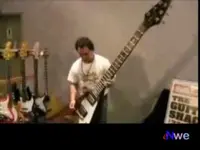I'd never argue that it's impossible to sound like crap with Line6 equipment, but is it *SO* impossible to sound like crap with an authentic tube amp and microphone? (You were apparently right in this case, but come on, there are some horrible sounding authentic analog & tube amp recordings out there.)
In the interests of full disclosure, I own a couple all-tube amps, I own
a Line6 Pod XTLive, and (through my day job) I'm legally defined as "a person of scientific competence [...] informed by scientific knowledge" in the field of computer simulation, emulation, and modeling. I do gag a little whenever I read that, though.

Most of the time I run my Line6 into an all-tube head just to piss off people on either side of the issue.
I'll be honest, I can't really argue with you here.
I think that really what it is is a combination of two factors, the state of modern modeling technology and user error. I've got a meeting in 10 minutes so I'll have to keep this REALLY quick, but...
1.) technology. Line6 is resting on their laurels. The bare-bones technology behind the Pod hans't changed fundamentally since probably the Pod 2.0, maybe the XT (I don't recall if they re-modeled the amps since). The newer Pods simply have a couple more models, and the options to run multiple models at the same time; nice, but not groundbreaking. It's the same modeling, the same speaker sims, the same technology.
This is beginning to change, but none of the new wave in modeling has gone mainstream yet. There's a LOT of talk about using impulses for cabinet simulation on the net; guys running a direct feed from their amp's FX send (or a line out from a load box) into the board, and then in the mix using an impulse file to "model" the response of a cab. I haven't tried it myself, but a lot of the guys I've talked to who have say their Line6's never sounded better than when they bypassed the speaker simulation and then used a cabinet impulse to model a cab. Likewise, I've heard people get excellent results going this route with tube rigs.
Meanwhile,
the AxeFX is evidently getting a name for itself as everything the Pod should have been - accurately point-to-point models of tube amps all the way down to adjustable poweramp saturation, sag, depth, and various other characteristics, and an almost absurd amount of user-tweakability (you can evidently take the power section of one amp, tweak it to your taste in ways that wouldn't even necessarily be possible with the real thing, and mate it to the preamp from another amp). It alledgedly even "feels" like a tube amp, but I haven't gotten a chance to play one yet.
So, the technology's out there, and it's just a matter of time before a paradigm shift where the game changes again. Mainstream modeling technology just isn't as good as the thing it's trying to recreate though.
2.) user error. Sad reality is my experience with Line6 is that a lot of the models are way overgained and have much more active EQ than the actual amps. I suspect a large part of the problem wiith some of the "worst offender" tones I've heard is simply that the guitars are
way too saturated. Just because the gain on the Recto Line6 model can go to 10 doesn't mean it necessarily
should.
I'll admit to have even flirted with the idea of buying a Pod Pro for late-night demo sessions - my guitars hang on the wall next to my bed, and I've sat up in bed in the middle of the night a few times to work out a part that just came to me before I forget it, and it'd be nice to be able to record it and not trust my memory - and partly for the challange of seeing if I could make it sound a bit less like a modeler than most of the clips I've heard. So far though I'm just more comfortable working wiith my Rectifier (and heres another problem with modeling - I LOVE some of the less well known sounds from the Recto, the cleans and the "raw" mode, yet I've never heard a modeler even try to do something other than the "modern" mode of the recto), and while I'm curious about
the AxeFX it sells for about as much as a high end tube head so I'm just not curious enough to spend that kind of cash.
Ten years down the road? Hell, I might even switch over, and I consider myself a tube snob. I'm REALLY curious to hear what's going to happen when modelers start paying more attention to modeling ppoweramp response at different levels, and stop trying to recreate existing amps and start trying to use their tools to create new sounds that might not be possible with tubes.
Anyway, 2PM, gotta run to that meeting!



 LOL Just kidding however there are some folks who do think that way around here, hopefully none of those kind of people has posted to this thread.
LOL Just kidding however there are some folks who do think that way around here, hopefully none of those kind of people has posted to this thread. ). It seems to me that a DI (with a proper selection of effects and simulators) is a step toward controlling the clarity, whereas micing a speaker cabinet complicates things. (Not saying it makes it worse, but it can complicate things.)
). It seems to me that a DI (with a proper selection of effects and simulators) is a step toward controlling the clarity, whereas micing a speaker cabinet complicates things. (Not saying it makes it worse, but it can complicate things.) but that is another topic too
but that is another topic too


